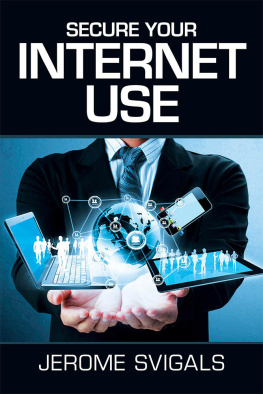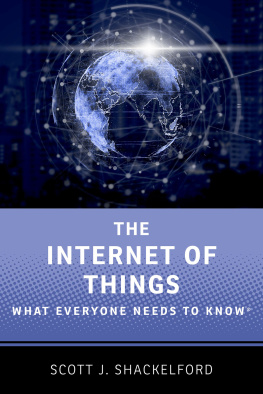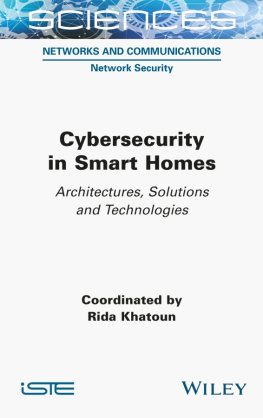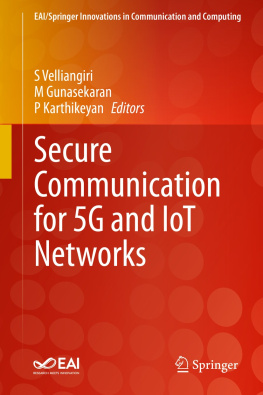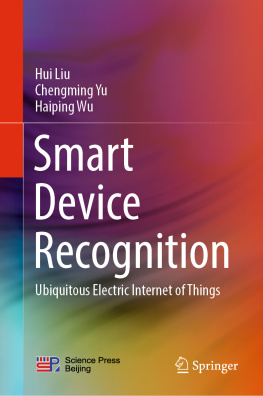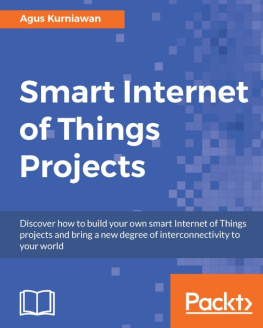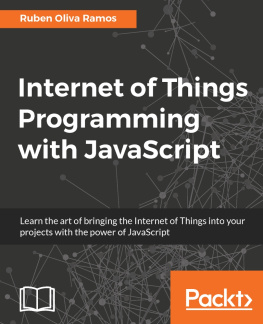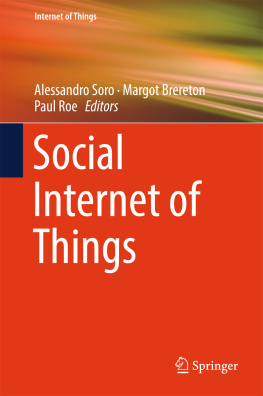Svigals - Secure Your Internet Use
Here you can read online Svigals - Secure Your Internet Use full text of the book (entire story) in english for free. Download pdf and epub, get meaning, cover and reviews about this ebook. year: 2016, publisher: Xlibris US;Svigals, Jerome, Xlibris Corp, genre: Computer. Description of the work, (preface) as well as reviews are available. Best literature library LitArk.com created for fans of good reading and offers a wide selection of genres:
Romance novel
Science fiction
Adventure
Detective
Science
History
Home and family
Prose
Art
Politics
Computer
Non-fiction
Religion
Business
Children
Humor
Choose a favorite category and find really read worthwhile books. Enjoy immersion in the world of imagination, feel the emotions of the characters or learn something new for yourself, make an fascinating discovery.
Secure Your Internet Use: summary, description and annotation
We offer to read an annotation, description, summary or preface (depends on what the author of the book "Secure Your Internet Use" wrote himself). If you haven't found the necessary information about the book — write in the comments, we will try to find it.
Secure Your Internet Use — read online for free the complete book (whole text) full work
Below is the text of the book, divided by pages. System saving the place of the last page read, allows you to conveniently read the book "Secure Your Internet Use" online for free, without having to search again every time where you left off. Put a bookmark, and you can go to the page where you finished reading at any time.
Font size:
Interval:
Bookmark:
SECURE YOUR INTERNET USE
Jerome Svigals
Copyright 2016 by Jerome Svigals.
ISBN: Softcover 978-1-5144-4967-7
eBook 978-1-5144-4966-0
All rights reserved. No part of this book may be reproduced or transmitted in any form or by any means, electronic or mechanical, including photocopying, recording, or by any information storage and retrieval system, without permission in writing from the copyright owner.
Any people depicted in stock imagery provided by Thinkstock are models, and such images are being used for illustrative purposes only.
Certain stock imagery Thinkstock.
Rev. date: 01/19/2016
Xlibris
1-888-795-4274
www.Xlibris.com
733197
CONTENTS
Purpose: Identify individuals Assistin g Us.
Action: Show apprecia tion.
A Dedication
As a 22 year old engineer in an 88 year old body, let me first thank the group of professionals that keep me alive and well. They include Drs Gary Aron, Bruce Benedick, Pardis Kelly, Philip Ng and (Mrs) Blanca Vargas of the Powerhouse Gym in Redwood City, CA. Also, many thanks to patent attorney Ed Radlo of Radloip, Los Gatos , CA.
Purpose: Provide an Introduction to this Book.
Action: Provide background necessary to use this book.
Purpose of this book: The transaction world is quickly evolving from an era of electronic transactions, based on plastic cards and readable checks, to a new era of smart device transactions, based on hand-held, communications based, stored program operated, transaction devices (Smart Devices) communicating via networks, primarily the world wide Inte rnet.
This book is intended to help you understand the use of Smart Devices on the Internet in preparing for the Internet security challenges. It is intended to introduce you to the Internet and its role, in the Smart Devices era.
Smart Devices Concepts
The hand held communicating smart (programmed) device has introduced a new way of life. It offers walking and traveling conversation. Stand on any street corner, in any city at any time of the day and you will observe all classes of society going bye with a hand held communications device being held next to their ear. Usage statistics claim more than 80% of the worlds population have access to and use a communicating phone like device. Their use ranges from socializing and safety to commercial and financial activities. The users range from 8 or 10 years old to immobile senior citizens seeking social interaction and a substitute for physical mo tion.
Smartphone Based Financial Transact ions:
The Smartphone is a hand-held, internet based, stored program computer which includes cell phone funct ions.
The Internet is a world wide network of computer based communication systems, using a common information protocol. Market migration to an all electronic, Smartphone based, financial transactions concept will have significant impact on conventional banking facilities. It will impact the physical attributes of the bank br anch.
Branch bank tellers for face-to-face transaction processing will disappear as they are replaced by remote smart devices, communications based, self service, transactions. It will significantly change the roll of branch banking personnel. It will reduce physical efforts such as mail delivery and processing. It will replace physical money and check needs with network/electronic based secure functions and strategies. Visits to the branch for transactions will be accomplished electronically. The business of Smartphone based banking will be 24/7. Successful bankers will need to move rapidly to keep up with the rapidly changing, remote, electronic functional environmental marketp lace.
Forces for Change
The forces for migration of the bank to a Smartphone based role change will include: (1) the rapid growth of cell phones and Smartphones as the prime vehicle of individual communications, and their replacing transaction cards; (2) the role of the Internet as the dominant world wide communications network in almost all industries including bank, health, retail, education and government; (3) the disappearance of paper in the bank industry, including the growth of electronic money, check images, and remote/interactive self service; and (4) the migration of bank based Smartphone systems from stand alone facilities to Cloud systems with the removal of all geographic and physical boundaries. A Cloud system is the users portion of a larger, internet based, remote computer system
Mobile Banking with Smartphones
Mobile banking is the use of a portable communications device to access and use financial services. This concept is well established with the use of wireless phones to find bank account balances and their status. As portable communications devices evolved into Smartphones, portable computers that allow phone calls, their banking functions are further increasing in sophistication. For example, Smartphones are now being used to capture and transmit check images for electronic deposits. The portable device also runs banking applications. For example, they can be used to calculate currency conversions and mortgage loan tables. Self service is the direct benefit of forty years of magnetic striped card based self service ban king.
The Internet
The Internet, a world-wide communications network, allows access from more points, more quickly and more easily than any other network in the history of networks. Thus, along with its new facilities comes new and serious security exposures. The three most challenging are (1) preventing the misuse of lost or stolen smart devices; (2) preventing the effective use of overheard transmissions; and (3) preventing the downloading of fraudulent applications, Malware or viruses. Since there is no central authority dealing with these security exposures, the users must insure that they are protecting Internet plans and banking activity programs. Their actions must protect your Internet plans and programs. Please take this note of caution very seriously. There are security tools to protect your Internet actions. Your goal must be to use them effectively. They are the SPARC Security Solut ions.
Purpose: Provide a summary of this Book.
This report is intended to help you understand the use of Smart Devices, e.g. Smartphones, on the Internet in preparing for Securing Your Internet Use. It is intended to introduce you to the Internet and its role, in the Internet based transactions and Internet of Things era.
The Internet
The Internet allows access from more points, more quickly and more easily than any other network in the history of networks. Thus, along with its new facilities comes new and serious security exposures. Since there is no central authority dealing with these security exposures, the users must insure that they are protecting Internet plans and banking activity programs. Their actions must protect your Internet plans and programs. There are security tools to protect your Internet actions. Your goal must be to use them effecti vely.
Card and Check Migration
Physical check entry to the bank disappeared with the advent of check image capture in ATMs, cell phones and Smartphones. However, the real test is the process by which the individual originates a check-like based payment. The payment needs to identify the payer and the payee. Where bills are being paid, the payee is identified by the demand for payment. The optical image feature of the Smartphone can be used to capture that data just as it is used to capture check images for proces sing.
The Plastic Card Equivalent Transaction
Use of the mobile banking device as a magnetic striped card equivalent signal source requires a wireless transmission from the mobile banking device to the signal accepting unit. A NFC, (Near Field Communications) signal is emitted by the mobile banking device. The mobile banking device displays multiple striped card equivalent type designations. A record is captured in the mobile banking unit for later reference, if needed. The acceptance device processes the card-like transaction into the banking system. The variable amount of the transaction is added to the signal transmitted in the NFC signal to the accepting device. The complete transaction data is then processed by the banking sy stem.
Next pageFont size:
Interval:
Bookmark:
Similar books «Secure Your Internet Use»
Look at similar books to Secure Your Internet Use. We have selected literature similar in name and meaning in the hope of providing readers with more options to find new, interesting, not yet read works.
Discussion, reviews of the book Secure Your Internet Use and just readers' own opinions. Leave your comments, write what you think about the work, its meaning or the main characters. Specify what exactly you liked and what you didn't like, and why you think so.

